
table of contents
- Drying
- Location
- On pad
- On a leash
- Tie Ristra
- In the oven
- In the dehydrator
- Grind to powder
- storage
The harvest of peppers, chilli peppers and others is usually rich and, above all, at the same time. But of course these tasty, often spicy vegetables cannot all be used in the kitchen at the same time. Therefore, they have to be preserved for later use. The different pods can be dried in different ways and so they can still be used in the kitchen months later if they are properly stored after drying.
Drying
Drying options
So that all pods, such as peppers, chilli, hot peppers and others are well stored after a rich harvest, they are dried if possible. Because in this way the water is withdrawn from them and they can be preserved for the winter and until the next harvest and used in the kitchen at any time. In this way everyone can make their own hot spices according to their taste. This is how the dry pods are stored whole. If these are later used in the kitchen, they can simply be soaked in water and then processed as normal according to the recipe. Another possibility is to make powder after drying, which is later simply added to food as a spice.
There are different types of drying:
- Chilli spread out lying down
- in the oven
- on the leash
- in a dehydrator, cheap if you already have one
- Hot peppers knotted as ristra
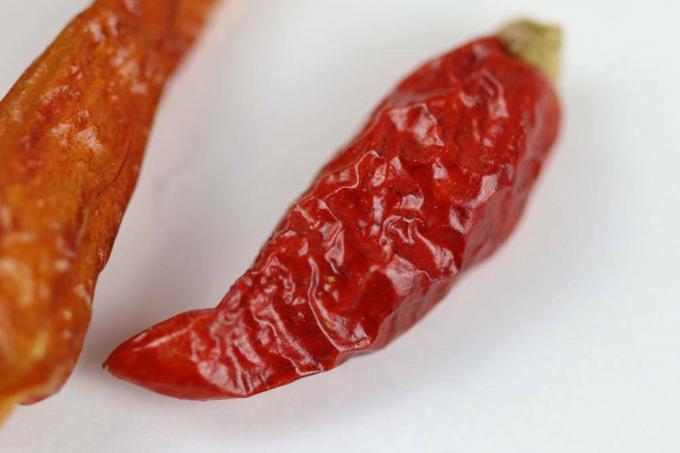
Drying in the air is not always suitable, as a dry, warm and well-ventilated place is needed for this when the weather does not cooperate. If the pods do not dry out properly because the place is not suitable for drying, then they can be attacked by mold or fungus, for example, or start to rot. In such a case, drying in the oven is recommended. Open pods or pods that have already been cut are ideally placed in the oven or a dehydrator.
Location
Place to dry
The correct location is important so that the pods are not damaged when they are dried. A place in direct sun is often not recommended, because then the fruits that still have water in them burn more easily. It is better to choose a warm, airy and dry place.
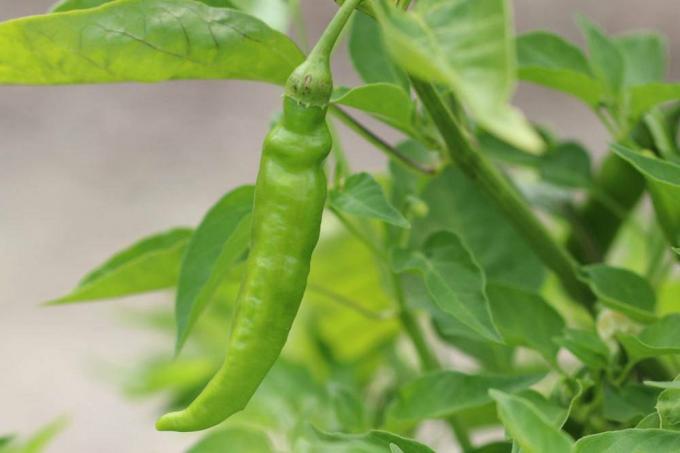
These include:
- a storage room
- a boiler room with windows for ventilation
- an unused laundry room
- if this is used, it is overall too damp
- a covered terrace or balcony without great sun exposure
It is important that the chosen location is protected from moisture or rain. Therefore, a location on a terrace or balcony is only suitable in summer, when there is no need to fear rain. Otherwise the humidity is too high here and it is better to choose a closed room.
On pad
Chilli on a mat
Air drying is of course the cheapest alternative to drying the pods, but it usually takes the longest. The easiest way to do this is to spread the pods out. Baking paper, linen or a large, clean wooden board can be used as a base. Because that is exactly one of the dry ways in the chilli cultivation areas. Many types of pods are suitable for air drying, especially the thin-fleshed varieties are ideal here, such as Cayenne Chile, Tabasco or Thai Dragon and of course many others. When drying horizontally in the air, you should therefore proceed as follows.
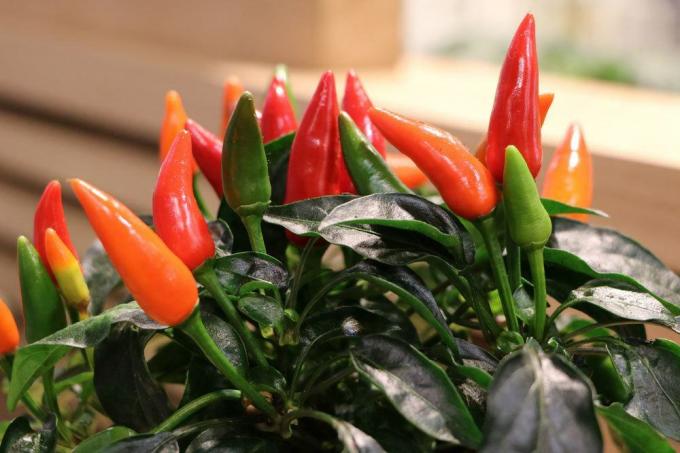
- choose a protected location
- Spread out cloth or paper
- alternatively place wooden slats next to each other on the floor
- then distribute the pods
- place so that they do not touch
- so there is enough air in the gaps
- low humidity is important
After about two weeks, the thin-walled pods should be dried in this way. If these are dry, they can be stored or processed into powder. The pods with a thick pulp, on the other hand, easily start to mold when air-dried, as the moisture remains in the pulp for too long. Different drying is therefore better for these varieties. The pods should also not be cut into slices before drying. Because with whole chili peppers, the skin protects against flies and dust. Pepperoni, in which the pulp is already exposed, are much more exposed to insects and dirt.
On a leash
Chilli on a leash
Thick-walled peppers can also be dried on a line. For this purpose, they are ideally halved with a sharp knife in advance. Then they are hung on a thin clothesline, which is pierced and pulled through the peppers. The leash is protected and hung out of direct sunlight in an airy room without a lot of humidity. A drying room or storage tank is ideal for this. However, in this process vitamins can be lost and pests such as flies can settle on the interfaces.
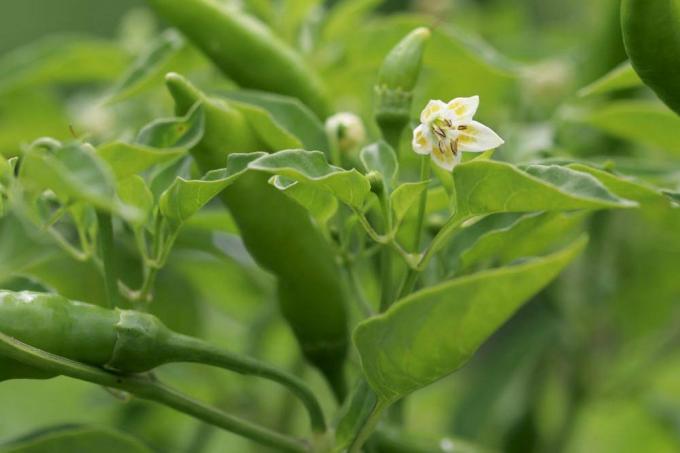
Tie Ristra
If you like it like in South America, you can also do the work and knot the peppers as ristras. This is not only decorative but also practical. Because it saves a lot of space and the tied pods also look beautiful and very decorative. Above all, they can be hung up to dry in practically any sheltered place. In addition, the chili peppers hanging in the kitchen are said to bring good luck. This type of knot can be found on the weekly markets from Hungary and Mexico in particular.
The Ristra is linked as follows:
- Use thin-walled chili peppers
- not every variety is suitable
- this requires a needle and thread for threading
- there must be a stalk on the pods
- tie a thick knot at the end of the thread
- pull the other end through the needle
- pull the cord through the stems with the needle
- ideally sort by size
- small pods at the bottom, getting larger at the top
- later looks more decorative
Ideally, the needle with the thread is pierced directly close to the crown, making sure that the angle is 45 °. It looks neater like this. Then several strands of chili are twisted together, which results in a decorative work of art. You can also pay attention to the color gradient. The ristras are then moved to an airy and warm place with little humidity and no direct sunlight hung up, it takes about two weeks for the peppers to be dry and processed or stored can.
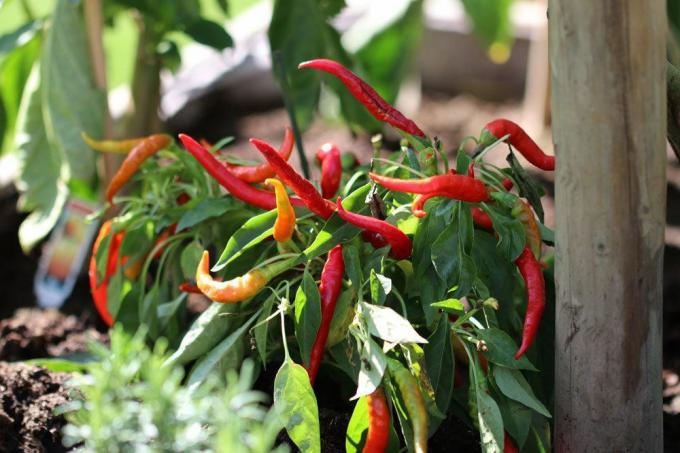
In the oven
Hot peppers in the oven
If you don't have a lot of time or space to spread the pods out and dry them in the air, you can dry different types of peppers and chilli in the oven on low heat. This type of drying is particularly suitable for the fleshy and thick-walled pods. Because these would have to lie in the air longer to dry out than the pod with a relatively thin skin. When drying the peppers in the oven, proceed as follows.
- Cut the chili peppers lengthways
- use a sharp knife for this
- remove the pips and the stem
- place the halved chili peppers on a baking sheet
- Parchment paper is helpful
- dry for six hours at about 75 ° Celsius
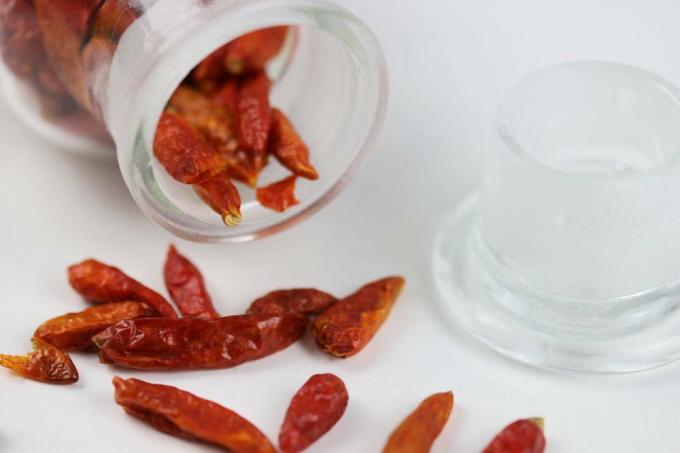
When the chillies are dry, they can be removed from the oven for storage or further processing. The kernels are mainly removed from the very hot varieties because this is where most of the heat is. If you like it very spicy, you can also dry the kernels and process them later.
In the dehydrator
If you often dry chilli, chili peppers or other fruit, you can do this in a dehydrator. This must of course be purchased and the purchase is only worthwhile if it is used several times. However, a dehydrator has the advantage of gentle yet quick drying. Because such a device can usually be set to different temperatures and has good, continuous air circulation.
It also has individual drying floors so that many chili peppers can be dried at once. The dehydrator is suitable for all types, regardless of whether they are thick-walled or thin-walled. The pods can be cut or dried whole.
Grind to powder
If the pods are dry, they can also be ground to powder and can be used in the kitchen as a spice, mixed with salt and pepper, or individually as chilli powder. Grinding the pods, which have to be really dry for this, is very easy. Either an electric coffee grinder is available for this or it is pushed by hand in a mortar. The advantage of the ground powder in a coffee grinder is that it is particularly fine.
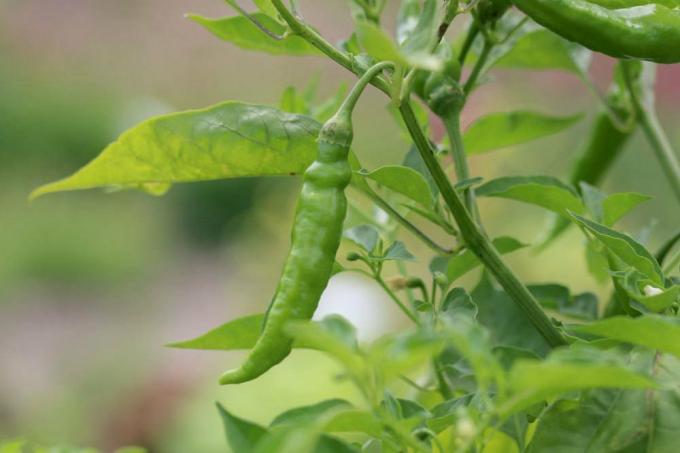
The powder from the mortar is usually a little coarser, but can be mixed with salt and other ingredients to make a delicious spice mixture. The coarse powder can also be put into a pepper or salt mill, then it comes out very finely grated at the end. The powder is kept in dry, easily sealable jars. Empty spice jars that have been stored in advance can also be used for this purpose. The advantage here is that these already have lids with small and larger holes, from which the powder is simply sprinkled out when used.
storage
Storing the chili peppers is also important so that they are not damaged during the storage period. Most importantly, the dried pods must also be stored in a dry place. If the peppers have already been dried on a ristra or a line, they can simply be left hanging in an airy room and removed if necessary. But storage in a breathable wooden box that is placed in a warm place is also a good solution.

The procedure for storing is as follows:
- for chili peppers store horizontally layer upon layer
- Place baking paper between the layers to prevent mold on stored chilli peppers
- regularly check that pods are still good
However, the dried pods can also be stored whole in a closed, airtight jar. However, this is only useful for a small amount.

